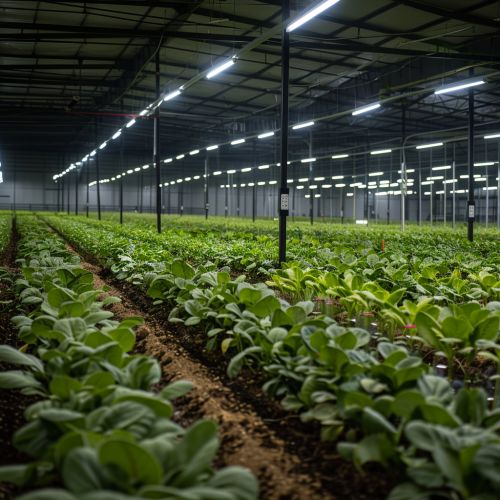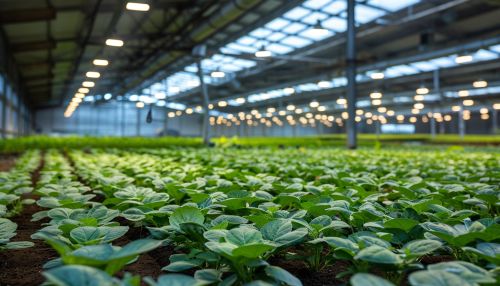Indoor Farming
Overview
Indoor farming, also known as controlled-environment agriculture (CEA), is a method of cultivating plants within an indoor setting, where all environmental factors can be controlled. This method of farming has gained popularity due to its potential to provide fresh produce year-round, regardless of external weather conditions.


History
The concept of indoor farming is not new, with the earliest known examples dating back to the Roman era. The Romans used primitive greenhouses, known as specularia, to grow cucumbers for the emperor Tiberius. However, the modern concept of indoor farming, with its focus on technology and sustainability, has its roots in the 20th century.
Types of Indoor Farming
There are several types of indoor farming, each with its own set of advantages and challenges.
Hydroponics
Hydroponics is a method of growing plants without soil, instead using a nutrient-rich water solution. This method allows for precise control over the nutrients the plants receive, and can result in faster growth and higher yields than traditional soil-based farming.
Aeroponics
In Aeroponics, plants are grown in an air or mist environment without the use of soil or an aggregate medium. This method uses less water than hydroponics and allows for greater oxygenation of the plant roots, potentially leading to even faster growth.
Aquaponics
Aquaponics combines hydroponics with aquaculture (the raising of aquatic animals such as fish) in a symbiotic environment. The waste from the fish serves as organic food for the plants, and the plants naturally filter the water for the fish.
Benefits of Indoor Farming
Indoor farming offers several benefits over traditional outdoor farming.
Controlled Environment
Indoor farming allows for complete control over the growing environment, including temperature, light, humidity, and CO2 levels. This control can lead to higher yields and more consistent quality.
Year-Round Production
Unlike outdoor farming, which is subject to seasonal changes, indoor farming can produce crops year-round. This can lead to higher overall productivity and the ability to grow crops that would not normally thrive in the local climate.
Reduced Water Usage
Indoor farming methods like hydroponics, aeroponics, and aquaponics use significantly less water than traditional farming. This makes indoor farming a more sustainable option in areas where water is scarce.
Challenges of Indoor Farming
Despite its benefits, indoor farming also presents several challenges.
High Initial Costs
Setting up an indoor farm can be expensive, with costs for equipment, construction, and technology potentially running into the millions of dollars.
Energy Usage
Indoor farms require a significant amount of energy, particularly for lighting and temperature control. This can lead to high operating costs and a larger carbon footprint, unless renewable energy sources are used.
Technical Knowledge
Operating an indoor farm requires a high level of technical knowledge and expertise. Farmers must understand plant biology, environmental control, and the specific technologies used in their farm.
Future of Indoor Farming
The future of indoor farming looks promising, with advancements in technology and an increasing focus on sustainability driving its growth. Innovations in LED lighting, automation, and data analytics are making indoor farming more efficient and cost-effective. At the same time, the growing demand for locally sourced, fresh produce is creating new markets for indoor farmers.
